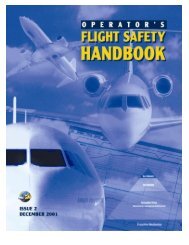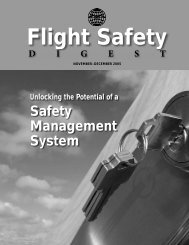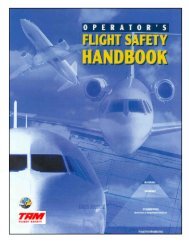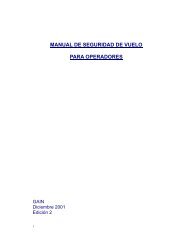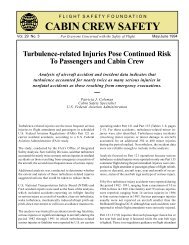Flight Safety Digest October 2005 - Flight Safety Foundation
Flight Safety Digest October 2005 - Flight Safety Foundation
Flight Safety Digest October 2005 - Flight Safety Foundation
Create successful ePaper yourself
Turn your PDF publications into a flip-book with our unique Google optimized e-Paper software.
16<br />
occurring on its own, or occurring only<br />
on occasion, could contribute to quite a<br />
different sense of working relationship.<br />
However, our suggestion is that these aspects,<br />
taken together and occurring over<br />
a substantial period on the CVR for this<br />
fl ight, point to a tendency for tasks to be<br />
performed in a way that can emphasize<br />
the pilots’ different individual statuses and<br />
roles, rather than a harmonious collaborative<br />
team working relationship. (The difference<br />
in status between pilots is often<br />
referred to as the trans-cockpit authority<br />
gradient. Gradients that are too fl at or too<br />
steep are generally considered to contribute<br />
to less effective crew coordination and<br />
communication [Hawkins, 1987].)<br />
Conclusion<br />
Our aim has been to describe the<br />
context for a human error, or to<br />
consider how an error can be understood<br />
as emerging from the immediate working<br />
environment as created by the pilots, in<br />
the ways in which they communicated<br />
and interacted with each other. We used<br />
a specifi c approach to naturally occurring<br />
communication and interaction, conversation<br />
analysis, to transcribe and analyze<br />
CVR data of one aviation accident, involving<br />
a commercially operated jet aircraft.<br />
We did not focus on the moment of<br />
error itself, but instead on the context in<br />
which it occurred, or what we have called<br />
an interactional context for error. We used<br />
segments from the CVR data, transcribed<br />
in rich detail using notation from conversation<br />
analysis, to suggest that aspects of<br />
the pilots’ interaction show the pilots to<br />
be acting according to, emphasizing, their<br />
individual statuses and roles as PIC and<br />
copilot, rather than a sense of working<br />
collaboratively as a team.<br />
We suggest that such aspects of interaction<br />
contribute to a working relationship that<br />
can be conducive to an error occurring<br />
and not being identifi ed: They can allow<br />
for a collaborative construction of error. The<br />
error that contributed directly to the accident,<br />
an incorrectly set descent altitude,<br />
can be seen as not the responsibility of one<br />
C ONVERSATION ANALYSIS<br />
pilot, but at least in part as the outcome<br />
of the way the two pilots communicated<br />
with one another.<br />
We considered the following aspects in<br />
particular: the signifi cance of overlapping<br />
talk (when both pilots spoke at the<br />
same time); the copilot’s silence after talk<br />
from the PIC; instances when the PIC<br />
corrected (repaired) the copilot’s talk or<br />
conduct; and lastly, a range of aspects for<br />
how the two pilots communicated to perform<br />
routine tasks. It is signifi cant to note<br />
that in pointing to evidence that the pilots’<br />
communication was problematic for<br />
their work as a team, it was not necessary<br />
to rely on analyzing instances of overt<br />
confl ict or communication breakdown.<br />
Communicative problems can build up,<br />
and be evidenced, over time.<br />
We hope to have demonstrated the<br />
value of looking closely at recorded<br />
voice data as a means for interpreting<br />
human performance and for interpreting<br />
human error in aviation in the light<br />
of the world evolving around the pilots<br />
at the time (Dekker, 2001a), and indeed<br />
as the pilots themselves create it. The<br />
approach we have used can allow systematic<br />
and data-based assertions about<br />
human action. How one represents data<br />
affects greatly what one is able to see in<br />
it and subsequently able to say about<br />
it. Conversation analysis is a microapproach<br />
to the transcription and analysis<br />
of naturally occurring interaction, and<br />
richly detailed transcriptions using notation<br />
of conversation analysis can make<br />
maximally visible how pilots themselves<br />
develop and understand their respective<br />
contributions to interaction and to the<br />
work required to operate their aircraft.<br />
This paper has shown what kind of analyses<br />
and fi ndings conversation analysis<br />
transcriptions can make possible.<br />
When analyzing recorded voice data, and<br />
especially for understanding instances of<br />
human error, often a great deal rests on<br />
investigators’ interpretations or analysts’<br />
interpretations of what a pilot said, or<br />
what was meant by what was said, or<br />
how talk was understood, or how the<br />
mood in the cockpit or the pilots’ working<br />
relationship could best be described.<br />
Conversation analysis can be a tool for<br />
making such interpretations. A particular<br />
value of conversation analysis as a qualitative<br />
method is that it can be applied to<br />
even very small amounts of data, even<br />
a single exchange of turns. By drawing<br />
on transcription and analytic methods<br />
arising from conversation analysis, it is<br />
possible to eschew attempts to “get into<br />
people’s heads” and conjecture what<br />
they are thinking and feeling. Actually<br />
analyzing language in use in aviation, or<br />
any other work setting, can involve much<br />
more than classifying and counting this<br />
or that type of utterance or action. It can<br />
involve seeing how language emerges in<br />
interaction in context, and serves to create<br />
context. ■<br />
[FSF editorial note: To ensure wider<br />
distribution in the interest of aviation<br />
safety, this report has been reprinted<br />
from the Australian Transport <strong>Safety</strong><br />
Bureau (ATSB) publication A Context<br />
for Error: Using Conversation Analysis<br />
to Represent and Analyse Recorded Voice<br />
Data, Aviation Research Report B<strong>2005</strong>/<br />
0108, June <strong>2005</strong>. Some editorial changes<br />
were made by FSF staff for clarity and for<br />
style. Maurice Nevile, Ph.D., is affi liated<br />
with the Division of Business, Law and<br />
Information Sciences at the University<br />
of Canberra (Australia), and Michael B.<br />
Walker, Ph.D., is with the ATSB.]<br />
References<br />
Australian Transport <strong>Safety</strong> Bureau (2001).<br />
Investigation Report 200003771, Pilot and<br />
Passenger Incapacitation, Beech Super King<br />
Air 200 VH-SKC, Wernadinga Station, Qld, 4<br />
September 2000. Department of Transport and<br />
Regional Services, Canberra, Australia.<br />
Brenner, M.; Cash, J.R. (1991). “Speech Analysis<br />
as an Index of Alcohol Intoxication — The<br />
Exxon Valdez Accident.” Aviation, Space, and<br />
Environmental Medicine, 62, 893–898.<br />
Brenner, M.; Doherty, E.T.; Shipp, T. (1994).<br />
“Speech Measures Indicating Workload<br />
Demand.” Aviation, Space, and Environmental<br />
Medicine, 65, 21–26.<br />
FLIGHT SAFETY FOUNDATION FLIGHT SAFETY DIGEST OCTOBER <strong>2005</strong>


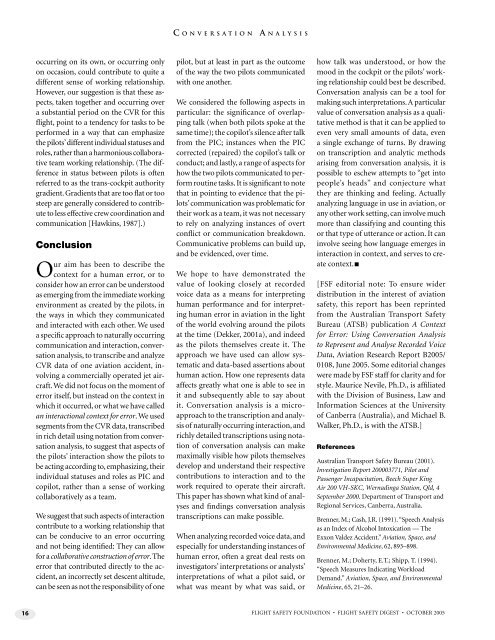

![Download this Issue [PDF 7 MB] - Flight Safety Foundation](https://img.yumpu.com/18859635/1/190x245/download-this-issue-pdf-7-mb-flight-safety-foundation.jpg?quality=85)
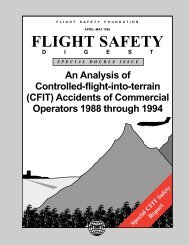
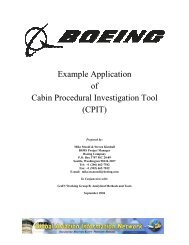
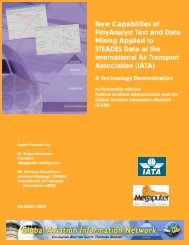
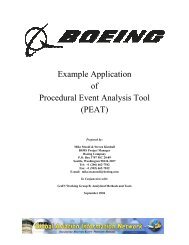
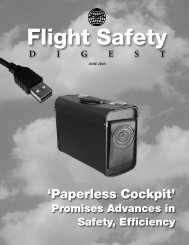
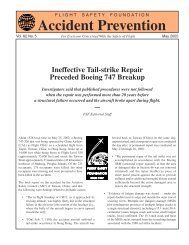
![Download [PDF 8 MB] - Flight Safety Foundation](https://img.yumpu.com/18859366/1/190x245/download-pdf-8-mb-flight-safety-foundation.jpg?quality=85)
